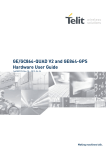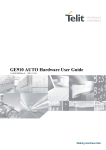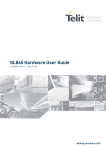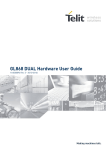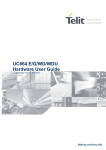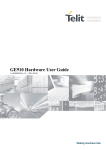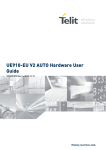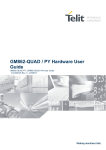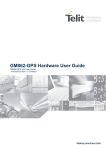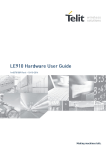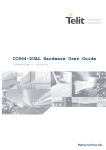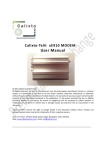Download GE864 Harware User Guide
Transcript
GE864-QUAD Automotive V2 Hardware User Guide 1vv0300840 Rev.3 – 2010-04-08 GE864-QUAD Automotive V2 Hardware User Guide 1vv0300840 Rev.3 2010-04-08 Applicable products PRODUCT GE864-QUAD Automotive V2 Reproduction forbidden without Telit Communications S.p.A. written authorization - All Rights Reserved page 2 of 71 GE864-QUAD Automotive V2 Hardware User Guide 1vv0300840 Rev.3 2010-04-08 Contents 1. Introduction ................................................................................................................ 7 1.1. Scope................................................................................................................................ 7 1.2. Contact Information, Support .......................................................................................... 7 1.3. Text Conventions.............................................................................................................. 8 1.4. Related Documents .......................................................................................................... 8 1.5. Document History ............................................................................................................ 8 2. Overview ..................................................................................................................... 9 3. GE864-QUAD Automotive V2 Mechanical Dimensions ...............................................10 4. GE864-QUAD Automotive V2 module connections .....................................................11 4.1. PIN-OUT ......................................................................................................................... 11 4.1.1. BGA Balls Layout............................................................................................................................... 15 5. Hardware Commands ................................................................................................17 5.1. Turning ON the GE864-QUAD Automotive V2 module ..................................................... 17 5.2. Turning OFF the GE864-QUAD Automotive V2 ................................................................ 19 Hardware Unconditional Restart..................................................................................................... 20 5.2.1. 6. Power Supply.............................................................................................................23 6.1. Power Supply Requirements .......................................................................................... 23 6.2. Power Consumption ....................................................................................................... 24 6.3. General Design Rules ..................................................................................................... 25 6.3.1. Electrical Design Guidelines............................................................................................................. 25 6.3.1.1. + 5V input Source Power Supply Design Guidelines..................................................................... 25 6.3.1.2. + 12V input Source Power Supply Design Guidelines................................................................... 26 6.3.1.3. Battery Source Power Supply Design Guidelines......................................................................... 27 6.3.2. Thermal Design Guidelines............................................................................................................... 29 6.3.3. Power Supply PCB layout Guidelines ............................................................................................... 30 7. Antenna .....................................................................................................................31 7.1. GSM Antenna Requirements........................................................................................... 31 7.2. GSM Antenna - PCB line Guidelines ............................................................................... 32 7.3. GSM Antenna - Installation Guidelines ........................................................................... 33 8. Logic level specifications ..........................................................................................34 8.1. Reset signal .................................................................................................................... 35 Reproduction forbidden without Telit Communications S.p.A. written authorization - All Rights Reserved page 3 of 71 GE864-QUAD Automotive V2 Hardware User Guide 1vv0300840 Rev.3 2010-04-08 9. Serial Ports ...............................................................................................................36 9.1. MODEM SERIAL PORT .................................................................................................... 36 9.2. RS232 level translation................................................................................................... 38 9.3. UART level translation.................................................................................................... 41 10. Audio Section Overview .............................................................................................43 10.1. Selection mode............................................................................................................ 43 10.2. Electrical Characteristics ........................................................................................... 45 10.2.1. Input Lines Characteristics............................................................................................................... 45 10.2.2. Output Lines Characteristics ............................................................................................................ 46 11. General Purpose I/O ..................................................................................................48 11.1. GPIO Logic levels ........................................................................................................ 49 11.2. Using a GPIO Pad as INPUT......................................................................................... 50 11.3. Using a GPIO Pad as OUTPUT...................................................................................... 50 11.4. Using the RF Transmission Control GPIO4.................................................................. 50 11.5. Using the RFTXMON Output GPIO5.............................................................................. 51 11.6. Using the Alarm Output GPIO6 .................................................................................... 51 11.7. Using the Buzzer Output GPIO7................................................................................... 51 11.8. Indication of network service availability .................................................................... 52 11.9. RTC Bypass out ........................................................................................................... 54 11.10. External SIM Holder Implementation .......................................................................... 54 12. DAC and ADC section.................................................................................................55 12.1. 12.1.1. 12.1.2. 12.1.3. 12.2. 12.2.1. 12.2.2. DAC Converter ............................................................................................................ 55 Description ........................................................................................................................................ 55 Enabling DAC..................................................................................................................................... 56 Low Pass Filter Example .................................................................................................................. 56 ADC Converter ............................................................................................................ 57 Description ........................................................................................................................................ 57 Using ADC Converter ........................................................................................................................ 57 13. Mounting the GE864-QUAD Automotive V2 on your Board .........................................58 13.1. General ....................................................................................................................... 58 13.2. Module finishing & dimensions ................................................................................... 58 13.3. Recommended foot print for the application............................................................... 59 Reproduction forbidden without Telit Communications S.p.A. written authorization - All Rights Reserved page 4 of 71 GE864-QUAD Automotive V2 Hardware User Guide 1vv0300840 Rev.3 2010-04-08 13.4. Debug of the GE864 in production ............................................................................... 60 13.5. Stencil ......................................................................................................................... 60 13.6. PCB pad design ........................................................................................................... 61 13.7. Solder paste ................................................................................................................ 62 GE864 Solder reflow.......................................................................................................................... 63 13.7.1. 14. Packing system .........................................................................................................65 14.1. GE864 orientation on the tray...................................................................................... 67 14.2. Moisture sensibility ..................................................................................................... 67 15. Conformity Assessment Issues .................................................................................68 16. SAFETY RECOMMANDATIONS ...................................................................................70 Reproduction forbidden without Telit Communications S.p.A. written authorization - All Rights Reserved page 5 of 71 GE864-QUAD Automotive V2 Hardware User Guide 1vv0300840 Rev.3 2010-04-08 Disclaimer The information contained in this document is the proprietary information of Telit Communications S.p.A. and its affiliates (“TELIT”). The contents are confidential and any disclosure to persons other than the officers, employees, agents or subcontractors of the owner or licensee of this document, without the prior written consent of Telit, is strictly prohibited. Telit makes every effort to ensure the quality of the information it makes available. Notwithstanding the foregoing, Telit does not make any warranty as to the information contained herein, and does not accept any liability for any injury, loss or damage of any kind incurred by use of or reliance upon the information. Telit disclaims any and all responsibility for the application of the devices characterized in this document, and notes that the application of the device must comply with the safety standards of the applicable country, and where applicable, with the relevant wiring rules. Telit reserves the right to make modifications, additions and deletions to this document due to typographical errors, inaccurate information, or improvements to programs and/or equipment at any time and without notice. Such changes will, nevertheless be incorporated into new editions of this document. Copyright: Transmittal, reproduction, dissemination and/or editing of this document as well as utilization of its contents and communication thereof to others without express authorization are prohibited. Offenders will be held liable for payment of damages. All rights are reserved. Copyright © Telit Communications S.p.A. 2010. Reproduction forbidden without Telit Communications S.p.A. written authorization - All Rights Reserved page 6 of 71 GE864-QUAD Automotive V2 Hardware User Guide 1vv0300840 Rev.3 2010-04-08 1. Introduction The information presented in this document is believed to be accurate and reliable. However, no responsibility is assumed by Telit Communications S.p.A. for its use, nor any infringement of patents or other rights of third parties which may result from its use. No license is granted by implication or otherwise under any patent rights of Telit Communications S.p.A. other than for circuitry embodied in Telit products. This document is subject to change without notice. 1.1. Scope The aim of this document is the description of some hardware solutions useful for developing a product with the Telit GE864-QUAD Automotive V2module. 1.2. Contact Information, Support For general contact, technical support, to report documentation errors and to order manuals, contact Telit Technical Support Center (TTSC) at: [email protected] [email protected] [email protected] [email protected] Alternatively, use: http://www.telit.com/en/products/technical-support-center/contact.php For detailed information about where you can buy the Telit modules or for recommendations on accessories and components visit: http://www.telit.com To register for product news and announcements or for product questions contact Telit Technical Support Center (TTSC). Our aim is to make this guide as helpful as possible. Keep us informed of your comments and suggestions for improvements. Telit appreciates feedback from the users of our information. Reproduction forbidden without Telit Communications S.p.A. written authorization - All Rights Reserved page 7 of 71 GE864-QUAD Automotive V2 Hardware User Guide 1vv0300840 Rev.3 2010-04-08 1.3. Text Conventions Danger – This information MUST be followed or catastrophic equipment failure or bodily injury may occur. Caution or Warning – Alerts the user to important points about integrating the module, if these points are not followed, the module and end user equipment may fail or malfunction. Tip or Information – Provides advice and suggestions that may be useful when integrating the module. All dates are in ISO 8601 format, i.e. YYYY-MM-DD. 1.4. 1.5. Related Documents SIM Holder Design Guides, 80000NT10001a SW User Guide, 1vv0300784 GE864-QUAD Automotive V2 Product Description, 80331ST10066a Audio settings application note , 80000NT10007a AT Commands Reference Guide 80000ST10025a Document History Revision Date Changes ISSUE#0 ISSUE#1 2009-07-01 2009-07-27 ISSUE#2 2010-03-30 ISSUE#3 2010-04-08 First Release from rev 7 of 1vv0300779 Changed par. 4.1 Turning ON and par. 5.1 Power supply Requirements Changed par. 12.3 Recommended foot print…. and par.14 Conformity Assessment Issues Applied new layout (paragraphs numbers shifted accordingly) Updated par. 9.3 5V UART level translation Updated chapter 10 The external function error on pin F3 Reproduction forbidden without Telit Communications S.p.A. written authorization - All Rights Reserved page 8 of 71 GE864-QUAD Automotive V2 Hardware User Guide 1vv0300840 Rev.3 2010-04-08 2. Overview The aim of this document is the description of some hardware solutions useful for developing a product with the Telit GE864-QUAD Automotive V2 module. In this document all the basic functions of a mobile phone module will be taken into account; for each one of them a proper hardware solution will be suggested and eventually the wrong solutions and common errors to be avoided will be evidenced. Obviously this document cannot embrace the whole hardware solutions and products that may be designed. The wrong solutions to be avoided shall be considered as mandatory, while the suggested hardware configurations shall not be considered mandatory, instead the information given shall be used as a guide and a starting point for properly developing your product with the Telit GE864-QUAD Automotive V2 module. For further hardware details that may not be explained in this document refer to the Telit GE864-QUAD Automotive V2 Product Description document where all the hardware information is reported. NOTE: The integration of the GSM/GPRS GE864-QUAD Automotive V2 cellular module within user application shall be done according to the design rules described in this manual. The information presented in this document is believed to be accurate and reliable. However, no responsibility is assumed by Telit Communications S.p.A. for its use, nor any infringement of patents or other rights of third parties which may result from its use. No license is granted by implication or otherwise under any patent rights of Telit Communications S.p.A. other than for circuitry embodied in Telit products. This document is subject to change without notice. Reproduction forbidden without Telit Communications S.p.A. written authorization - All Rights Reserved page 9 of 71 GE864-QUAD Automotive V2 Hardware User Guide 1vv0300840 Rev.3 2010-04-08 3. GE864-QUAD Automotive V2 Mechanical Dimensions The Telit GE864-QUAD Automotive V2 module overall dimension are: Length: Width: Thickness: Weight: 30 mm 30 mm 2.9 mm 5,2 g/4,2g Reproduction forbidden without Telit Communications S.p.A. written authorization - All Rights Reserved page 10 of 71 GE864-QUAD Automotive V2 Hardware User Guide 1vv0300840 Rev.3 2010-04-08 4. GE864-QUAD Automotive V2 module connections 4.1. PIN-OUT Ball Signal I/O Function Internal PULL UP Type Audio F9 AXE I G8 MIC_HF+ AI G9 MIC_MT- AI G10 EAR_MT+ AO J8 MIC_MT+ AI J9 MIC_HF- AI J10 EAR_HF- AO Handsfree switching Handsfree mic. input; phase +, nom. level 3mVrms Handset mic.signal input; phase-, nom. level 50mVrms Handset earphone signal output, phase + Handset mic.signal input; phase+, nom. level 50mVrms Handsfree mic.input; phase -, nom. level 3mVrms Handsfree ear output, phase - 100K CMOS 2.8V H9 EAR_MT- AO Handset earphone signal output, phase - Audio H10 EAR_HF+ AO Handsfree ear output, phase + Audio Audio Audio Audio Audio Audio Audio SIM card interface C10 SIMCLK O External SIM signal – Clock 1,8 / 3V C11 SIMIN I External SIM signal - Presence (active low) D4 SIMVCC - External SIM signal – Power supply for the SIM 1,8 / 3V D10 SIMIO I/O External SIM signal - Data I/O 1,8 / 3V E9 SIMRST O External SIM signal – Reset 1,8 / 3V D11 TX_TRACE O TX Data for debug monitor CMOS 2.8V F10 RX_TRACE I RX Data for debug monitor CMOS 2.8V 47K 1,8 / 3V Trace Prog. / Data + HW Flow Control B6 C125/RING O Output for Ring indicator signal (RI) to DTE Input for Data terminal ready signal (DTR) from DTE Output for Data carrier detect signal (DCD) to DTE Serial data input (TXD) from DTE CMOS 2.8V B7 C108/DTR I D9 C109/DCD O E7 C103/TXD I E11 C107/DSR O CMOS 2.8V O Output for Data set ready signal (DSR) to DTE Input for Request to send signal (RTS) from DTE Output for Clear to send signal (CTS) to DTE F7 C105/RTS I F6 C106/CTS H8 C104/RXD O Serial data output to DTE CMOS 2.8V CMOS 2.8V CMOS 2.8V CMOS 2.8V CMOS 2.8V CMOS 2.8V DAC and ADC C7 DAC_OUT AO Digital/Analog converter output D/A J11 ADC_IN1 AI Analog/Digital converter input A/D H11 ADC_IN2 AI Analog/Digital converter input A/D Miscellaneous Functions A2 RESET* I Reset input Reproduction forbidden without Telit Communications S.p.A. written authorization - All Rights Reserved page 11 of 71 GE864-QUAD Automotive V2 Hardware User Guide 1vv0300840 Rev.3 2010-04-08 Ball Signal I/O Function Internal PULL UP Type D8 STAT_LED O Status indicator led CMOS 1.8V E2 VRTC AO Power J5 ON_OFF* I L8 PWRMON O VRTC Input command for switching power ON or OFF (toggle command). The pulse to be sent to the 47K GE864-QUAD Automotive V2 must be equal or greater than 1 second. Power ON Monitor L4 Antenna O Antenna output – 50 ohm RF E6 GPIO_01 / JDR I/O Telit GPIO01 I/O pin / Jammer detect report CMOS 2.8V H5 GPIO_02/PCM_WAO I/O Telit GPIO02 Configurable GPIO / PCM audio * CMOS 2.8V K7 GPIO_03 / PCM_RX I/O CMOS 2.8V B3 GPIO_04 I/O K8 GPIO_05 / RFTXMON I/O B5 GPIO_06 / ALARM I/O Telit GPIO03 Configurable GPIO / PCM audio * Telit GPIO04 Configurable GPIO / RF Transmission Control Telit GPIO05 Configurable GPIO / Transmitter ON monitor Telit GPIO06 Configurable GPIO / ALARM L9 GPIO_07 / BUZZER I/O Telit GPIO07 Configurable GPIO / Buzzer CMOS 2.8V H3 GPIO_08 / PCM_TX I/O Telit GPIO08 Configurable GPIO / PCM audio * CMOS 2.8V D7 GPIO_09 / PCM_CLK I/O Telit GPIO09 Configurable GPIO / PCM audio * CMOS 2.8V Pull up to VBATT CMOS 2.8V Telit GPIO CMOS 2.8V CMOS 2.8V CMOS 2.8V Power Supply J1 VBATT - Main power supply Power K1 VBATT - Main power supply Power J2 VBATT - Main power supply Power K2 VBATT - Main power supply Power A1 GND - Ground Power A11 GND - Ground Power D6 GND - Ground Power F1 GND - Ground Power F11 GND - Ground Power H1 GND - Ground Power H2 GND - Ground Power J3 GND - Ground Power K3 GND - Ground Power K4 GND - Ground Power K5 GND - Ground Power K6 GND - Ground Power L1 GND - Ground Power L2 GND - Ground Power L3 GND - Ground Power L6 GND - Ground Power L11 GND - Ground Power A3 - - Reserved RESERVED Reproduction forbidden without Telit Communications S.p.A. written authorization - All Rights Reserved page 12 of 71 GE864-QUAD Automotive V2 Hardware User Guide 1vv0300840 Rev.3 2010-04-08 Ball Signal I/O Function A4 - - Reserved A5 - - Reserved A6 - - Reserved A7 - - Reserved A8 - - Reserved A9 - - Reserved A10 - - Reserved B1 - - Reserved B2 - - Reserved B4 - - Reserved B8 - - Reserved B9 - - Reserved B10 - - Reserved B11 - - Reserved C1 - - Reserved C2 - - Reserved C3 - - Reserved C4 - - Reserved C5 - - Reserved C6 - - Reserved C8 - - Reserved C9 - - Reserved D1 - - Reserved D2 - - Reserved D3 - - Reserved D5 - - Reserved E1 - - Reserved E3 - - Reserved E4 - - Reserved E5 - - Reserved E8 - - Reserved E10 - - Reserved F2 - - Reserved F3 - - Reserved F4 - - Reserved F5 - - Reserved F8 - - Reserved G1 - - Reserved G2 - - Reserved G3 - - Reserved G4 - - Reserved G5 - - Reserved G6 - - Reserved Internal PULL UP Reproduction forbidden without Telit Communications S.p.A. written authorization - All Rights Reserved Type page 13 of 71 GE864-QUAD Automotive V2 Hardware User Guide 1vv0300840 Rev.3 2010-04-08 Ball Signal I/O Function G7 - - Reserved G11 - - Reserved H4 - - Reserved H6 - - Reserved H7 - - Reserved J4 - - Reserved J6 - - Reserved J7 - - Reserved K9 - - Reserved K10 - - Reserved K11 - - Reserved L5 - - Reserved L7 - - Reserved L10 - - Reserved Internal PULL UP Type * Ref. to Digital Voice Interface Application Note 80000NT10004a. NOTE: RESERVED pins must not be connected NOTE: RTS must be connected to the GND (on the module side) if flow control is not used. NOTE: If not used, almost all pins should be left disconnected. The only exceptions are the following pins: pin J1,K1,J2,K2 A1,F1,H1,L1,H2,L2,J3,K3,L3, K4,K5,D6,K6,L6,A11,F11,L11 J5 E7 A2 H8 signal VBATT GND ON/OFF* TXD RESET* RXD Reproduction forbidden without Telit Communications S.p.A. written authorization - All Rights Reserved page 14 of 71 GE864-QUAD Automotive V2 Hardware User Guide 1vv0300840 Rev.3 2010-04-08 4.1.1. BGA Balls Layout TOP VIEW A B C D E F G H J K L 1 GND - - - - GND - GND VBATT VBATT GND 2 RESET* - - - VRTC - - GND VBATT VBATT GND 3 - GPIO_04 - - - - - GPIO_08 / PCM_TX GND GND GND 4 -- - - SIMVCC - - - - - GND Antenna 5 - GPIO_06 / ALARM - - - - - GPIO_02 / PCM_WAO ON_OFF* GND - 6 - C125/RING - GND GPIO_01 / JDR C106 / CTS - - - GND GND 7 - C108 / DTR DAC_OUT GPIO_09 / PCM_CLK C103 / TXD C105 / RTS - - - GPIO_03/ PCM_RX - 8 - - - STAD_ LED - - MIC_HF+ C104 / RXD MIC_MT+ GPIO_05 / RFTXMON PWRMON 9 - - - C109 / DCD SIMRST AXE MIC_MT- EAR_MT- MIC_HF- - GPIO_07 / BUZZER 10 - - SIMCLK SIMIO - RX_TRACE EAR_MT+ EAR_HF+ EAR_HF- - - 11 GND - SIMIN TX_TRACE C107 / DSR GND - ADC_IN2 ADC_IN1 - GND Reproduction forbidden without Telit Communications S.p.A. written authorization - All Rights Reserved page 15 of 71 GE864-QUAD Automotive V2 Hardware User Guide 1vv0300840 Rev.3 2010-04-08 AUDIO Signals balls SIM CARD interface balls TRACE Signals balls Prog. / data + Hw Flow Control signals balls ADC signals balls MISCELLANEOUS functions signals balls TELIT GPIO balls POWER SUPPLY VBATT balls POWER SUPPLY GND balls RESERVED Reproduction forbidden without Telit Communications S.p.A. written authorization - All Rights Reserved page 16 of 71 GE864-QUAD Automotive V2 Hardware User Guide 1vv0300840 Rev.3 2010-04-08 5. Hardware Commands 5.1. Turning ON the GE864-QUAD Automotive V2 module To turn on the GE864-QUAD Automotive V2 the pad ON* must be tied low for at least 1 seconds and then released. When the power supply voltage is lower than 3.4V the pad ON# must be tied low for at least 3 seconds. The maximum current that can be drained from the ON* pad is 0,1 mA. A simple circuit to do it is: NOTE: don't use any pull up resistor on the ON* line, it is internally pulled up. Using pull up resistor may bring to latch up problems on the GE864-QUAD Automotive V2 power regulator and improper power on/off of the module. The line ON* must be connected only in open collector configuration. NOTE: In this document all the lines that are inverted, hence have active low signals are labeled with a name that ends with a "*" . TIP: To check if the device has powered on, the hardware line PWRMON should be monitored. After 00ms the line raised up the device could be considered powered on. NOTE: It is recommended to avoid having any HIGH logic level signal applied to the digital pins of the GE864-QUAD Automotive V2when the module is powered off. Reproduction forbidden without Telit Communications S.p.A. written authorization - All Rights Reserved page 17 of 71 GE864-QUAD Automotive V2 Hardware User Guide 1vv0300840 Rev.3 2010-04-08 A flow chart showing the proper turn on procedure is displayed below: Reproduction forbidden without Telit Communications S.p.A. written authorization - All Rights Reserved page 18 of 71 GE864-QUAD Automotive V2 Hardware User Guide 1vv0300840 Rev.3 2010-04-08 For example: 1- Let's assume you need to drive the ON* pad with a totem pole output from +1.8V up to 5V microcontroller (uP_OUT1): 2- Let's assume you need to drive the ON* pad directly with an ON/OFF button: 5.2. Turning OFF the GE864-QUAD Automotive V2 The turning off of the device can be done in two ways: via AT command (see GE864-QUAD / PY Software User Guide) by tying low pin ON# Either ways, when the device issues a detach request to the network informing that the device will not be reachable any more. To turn OFF the GE864-QUAD / PY the pad ON# must be tied low for at least 2 seconds and then released. The same circuitry and timing for the power on shall be used. The device shuts down after the release of the ON# pad. Reproduction forbidden without Telit Communications S.p.A. written authorization - All Rights Reserved page 19 of 71 GE864-QUAD Automotive V2 Hardware User Guide 1vv0300840 Rev.3 2010-04-08 TIP: To check if the device has powered off, the hardware line PWRMON must be monitored. When PWRMON goes low, the device has powered off. 5.2.1. Hardware Unconditional Restart WARNING: The hardware unconditional Restart must not be used during normal operation of the device since it does not detach the device from the network. It shall be kept as an emergency exit procedure to be done in the rare case that the device gets stacked waiting for some network or SIM responses. To unconditionally restart the GE864-QUAD / PY, the pad RESET# must be tied low for at least 200 milliseconds and then released. The maximum current that can be drained from the ON# pad is 0.15 mA. Reproduction forbidden without Telit Communications S.p.A. written authorization - All Rights Reserved page 20 of 71 GE864-QUAD Automotive V2 Hardware User Guide 1vv0300840 Rev.3 2010-04-08 A simple circuit to do it is: NOTE: Do not use any pull up resistor on the RESET# line nor any totem pole digital output. Using pull up resistor may bring to latch up problems on the GE864-QUAD / PY power regulator and improper functioning of the module. The line RESET# must be connected only in open collector configuration. TIP: The unconditional hardware Restart must always be implemented on the boards and must be used by the software as an emergency exit procedure. Reproduction forbidden without Telit Communications S.p.A. written authorization - All Rights Reserved page 21 of 71 GE864-QUAD Automotive V2 Hardware User Guide 1vv0300840 Rev.3 2010-04-08 The following flow chart shows the proper Reset procedure: For example: Let us assume you need to drive the RESET# pad with a totem pole output of a +3/5 V microcontroller (uP_OUT2): This signal is internally pulled up so the pin can be left floating if not used. Reproduction forbidden without Telit Communications S.p.A. written authorization - All Rights Reserved page 22 of 71 GE864-QUAD Automotive V2 Hardware User Guide 1vv0300840 Rev.3 2010-04-08 6. Power Supply The power supply circuitry and board layout are a very important part in the full product design and they strongly reflect on the product overall performances, hence read carefully the requirements and the guidelines that will follow for a proper design. 6.1. Power Supply Requirements POWER SUPPLY Nominal Supply Voltage 3.8V Max Supply Voltage 4.2V Operating Supply Voltage Range 3.4V – 4.2V Wide Supply Voltage tolerant 3.25V – 4.2V TIP: the supply voltage is directly measured between VBATT and GND balls. It must stay within the Wide Supply Voltage tolerant range including any drop voltage and overshoot voltage (during the slot tx, for example). NOTE: The Operating Voltage Range MUST never be exceeded also in power off condition; care must be taken in order to fulfill min/max voltage requirement NOTE: When the power supply voltage is lower than 3.4V, to turn ON the module, the pad ON# must be tied low for at least 3 seconds. See para 5.1 Reproduction forbidden without Telit Communications S.p.A. written authorization - All Rights Reserved page 23 of 71 GE864-QUAD Automotive V2 Hardware User Guide 1vv0300840 Rev.3 2010-04-08 6.2. Power Consumption The GE864-QUAD Automotive V2 power consumptions are: Average (mA) SWITCHED OFF Switched Off <62uA Mode AT+CFUN=1 19,0 AT+CFUN=4 18,0 3,9 2,9 AT+CFUN=0 or =5 2,1 1,9 1,6 CSD TX and RX mode GSM900 CSD PL5 305,0 DCS1800 CSD PL0 208,0 GPRS (class 10) 1TX GSM900 PL5 264,0 DCS1800 PL0 176,0 GPRS (class 10) 2TX GSM900 PL5 473,8 DCS1800 PL0 307,8 Mode description Module supplied but Switched Off IDLE mode Normal mode: full functionality of the module Disabled TX and RX; module is not registered on the network Paging Multiframe 2 Paging Multiframe 4 Paging Multiframe 6 Paging Multiframe 8 Paging Multiframe 9 GSM VOICE CALL GPRS Sending data mode GPRS Sending data mode The GSM system is made in a way that the RF transmission is not continuous, else it is packed into bursts at a base frequency of about 216 Hz, the relative current peaks can be as high as about 2A. Therefore the power supply has to be designed in order to withstand with these current peaks without big voltage drops; this means that both the electrical design and the board layout must be designed for this current flow. If the layout of the PCB is not well designed a strong noise floor is generated on the ground and the supply; this will reflect on all the audio paths producing an audible annoying noise at 216 Hz; if the voltage drop during the peak current absorption is too much, then the device may even shutdown as a consequence of the supply voltage drop. TIP: The electrical design for the Power supply should be made ensuring it will be capable of a peak current output of at least 2A. Reproduction forbidden without Telit Communications S.p.A. written authorization - All Rights Reserved page 24 of 71 GE864-QUAD Automotive V2 Hardware User Guide 1vv0300840 Rev.3 2010-04-08 6.3. General Design Rules The principal guidelines for the Power Supply Design embrace three different design steps: the electrical design the thermal design the PCB layout. 6.3.1. Electrical Design Guidelines The electrical design of the power supply depends strongly from the power source where this power is drained. We will distinguish them into three categories: +5V input (typically PC internal regulator output) +12V input (typically automotive) Battery 6.3.1.1. + 5V input Source Power Supply Design Guidelines The desired output for the power supply is 3.8V, hence there's not a big difference between the input source and the desired output and a linear regulator can be used. A switching power supply will not be suited because of the low drop out requirements. When using a linear regulator, a proper heat sink shall be provided in order to dissipate the power generated. A Bypass low ESR capacitor of adequate capacity must be provided in order to cut the current absorption peaks close to the GE864-QUAD Automotive V2, a 100μF tantalum capacitor is usually suited. Make sure the low ESR capacitor on the power supply output (usually a tantalum one) is rated at least 10V. A protection diode should be inserted close to the power input, in order to save the GE864-QUAD Automotive V2 from power polarity inversion. Reproduction forbidden without Telit Communications S.p.A. written authorization - All Rights Reserved page 25 of 71 GE864-QUAD Automotive V2 Hardware User Guide 1vv0300840 Rev.3 2010-04-08 An example of linear regulator with 5V input is: 6.3.1.2. + 12V input Source Power Supply Design Guidelines The desired output for the power supply is 3.8V, hence due to the big difference between the input source and the desired output, a linear regulator is not suited and shall not be used. A switching power supply will be preferable because of its better efficiency especially with the 2A peak current load represented by the GE864-QUAD Automotive V2. When using a switching regulator, a 500kHz or more switching frequency regulator is preferable because of its smaller inductor size and its faster transient response. This allows the regulator to respond quickly to the current peaks absorption. In any case the frequency and Switching design selection is related to the application to be developed due to the fact the switching frequency could also generate EMC interferences. For car PB battery the input voltage can rise up to 15,8V and this should be kept in mind when choosing components: all components in the power supply must withstand this voltage. A Bypass low ESR capacitor of adequate capacity must be provided in order to cut the current absorption peaks, a 100μF tantalum capacitor is usually suited. Make sure the low ESR capacitor on the power supply output (usually a tantalum one) is rated at least 10V. For Car applications a spike protection diode should be inserted close to the power input, in order to clean the supply from spikes. Reproduction forbidden without Telit Communications S.p.A. written authorization - All Rights Reserved page 26 of 71 GE864-QUAD Automotive V2 Hardware User Guide 1vv0300840 Rev.3 2010-04-08 A protection diode should be inserted close to the power input, in order to save the GE864-QUAD Automotive V2 from power polarity inversion. This can be the same diode as for spike protection. An example of switching regulator with 12V input is in the below schematic (it is split in 2 parts): 6.3.1.3. Battery Source Power Supply Design Guidelines The desired nominal output for the power supply is 3.8V and the maximum voltage allowed is 4.2V, hence a single 3.7V Li-Ion cell battery type is suited for supplying the power to the Telit GE864-QUAD Automotive V2 module. The three cells Ni/Cd or Ni/MH 3,6 V Nom. battery types or 4V PB types MUST NOT BE USED DIRECTLY since their maximum voltage can rise over the absolute maximum voltage for the GE864-QUAD Automotive V2 and damage it. Reproduction forbidden without Telit Communications S.p.A. written authorization - All Rights Reserved page 27 of 71 GE864-QUAD Automotive V2 Hardware User Guide 1vv0300840 Rev.3 2010-04-08 WARNING: DON'T USE any Ni-Cd, Ni-MH, and Pb battery types directly connected with GE864-QUAD Automotive V2. Their use can lead to overvoltage on the GE864QUAD Automotive V2 and damage it. USE ONLY Li-Ion battery types. A Bypass low ESR capacitor of adequate capacity must be provided in order to cut the current absorption peaks, a 100μF tantalum capacitor is usually suited. Make sure the low ESR capacitor (usually a tantalum one) is rated at least 10V. A protection diode should be inserted close to the power input, in order to save the GE864-QUAD Automotive V2 from power polarity inversion. Otherwise the battery connector should be done in a way to avoid polarity inversions when connecting the battery. The battery capacity must be at least 500mAh in order to withstand the current peaks of 2A; the suggested capacity is from 500mAh to 1000mAh. Reproduction forbidden without Telit Communications S.p.A. written authorization - All Rights Reserved page 28 of 71 GE864-QUAD Automotive V2 Hardware User Guide 1vv0300840 Rev.3 2010-04-08 6.3.2. Thermal Design Guidelines The thermal design for the power supply heat sink should be done with the following specifications: Average current consumption during transmission @PWR level max: 500mA Average current consumption during transmission @ PWR level min: 100mA Average current during Power Saving (CFUN=5): 4mA Average current during idle (Power Saving disabled) 24mA NOTE: The average consumption during transmissions depends on the power level at which the device is requested to transmit by the network. The average current consumption hence varies significantly. Considering the very low current during idle, especially if Power Saving function is enabled, it is possible to consider from the thermal point of view that the device absorbs current significantly only during calls. If we assume that the device stays into transmission for short periods of time (let's say few minutes) and then remains for a quite long time in idle (let's say one hour), then the power supply has always the time to cool down between the calls and the heat sink could be smaller than the calculated one for 500mA maximum RMS current, or even could be the simple chip package (no heat sink). Moreover in the average network conditions the device is requested to transmit at a lower power level than the maximum and hence the current consumption will be less than the 500mA, being usually around 150mA. For these reasons the thermal design is rarely a concern and the simple ground plane where the power supply chip is placed can be enough to ensure a good thermal condition and avoid overheating. For the heat generated by the GE864-QUAD Automotive V2, you can consider it to be during transmission 1W max during CSD/VOICE calls and 2W max during class10 GPRS upload. This generated heat will be mostly conducted to the ground plane under the GE864QUAD Automotive V2; you must ensure that your application can dissipate it. Reproduction forbidden without Telit Communications S.p.A. written authorization - All Rights Reserved page 29 of 71 GE864-QUAD Automotive V2 Hardware User Guide 1vv0300840 Rev.3 2010-04-08 6.3.3. Power Supply PCB layout Guidelines As seen on the electrical design guidelines the power supply shall have a low ESR capacitor on the output to cut the current peaks and a protection diode on the input to protect the supply from spikes and polarity inversion. The placement of these components is crucial for the correct working of the circuitry. A misplaced component can be useless or can even decrease the power supply performances. The Bypass low ESR capacitor must be placed close to the Telit GE864-QUAD Automotive V2 power input pads or in the case the power supply is a switching type it can be placed close to the inductor to cut the ripple provided the PCB trace from the capacitor to the GE864-QUAD Automotive V2 is wide enough to ensure a dropless connection even during the 2A current peaks. The protection diode must be placed close to the input connector where the power source is drained. The PCB traces from the input connector to the power regulator IC must be wide enough to ensure no voltage drops occur when the 2A current peaks are absorbed. Note that this is not made in order to save power loss but especially to avoid the voltage drops on the power line at the current peaks frequency of 216 Hz that will reflect on all the components connected to that supply, introducing the noise floor at the burst base frequency. For this reason while a voltage drop of 300-400 mV may be acceptable from the power loss point of view, the same voltage drop may not be acceptable from the noise point of view. If your application doesn't have audio interface but only uses the data feature of the Telit GE864-QUAD Automotive V2, then this noise is not so disturbing and power supply layout design can be more forgiving. The PCB traces to the GE864-QUAD Automotive V2 and the Bypass capacitor must be wide enough to ensure no significant voltage drops occur when the 2A current peaks are absorbed. This is for the same reason as previous point. Try to keep this trace as short as possible. The PCB traces connecting the Switching output to the inductor and the switching diode must be kept as short as possible by placing the inductor and the diode very close to the power switching IC (only for switching power supply). This is done in order to reduce the radiated field (noise) at the switching frequency (100-500 kHz usually). The use of a good common ground plane is suggested. The placement of the power supply on the board should be done in such a way to guarantee that the high current return paths in the ground plane are not overlapped to any noise sensitive circuitry as the microphone amplifier/buffer or earphone amplifier. The power supply input cables should be kept separate from noise sensitive lines such as microphone/earphone cables. Reproduction forbidden without Telit Communications S.p.A. written authorization - All Rights Reserved page 30 of 71 GE864-QUAD Automotive V2 Hardware User Guide 1vv0300840 Rev.3 2010-04-08 7. Antenna The antenna connection and board layout design are the most important part in the full product design and they strongly reflect on the product overall performances, hence read carefully and follow the requirements and the guidelines for a proper design. 7.1. GSM Antenna Requirements As suggested on the Product Description the antenna and antenna line on PCB for a Telit GE864-QUAD Automotive V2 device shall fulfill the following requirements: ANTENNA REQUIREMENTS Frequency range Depending by frequency band(s) provided by the network operator, the customer shall use the most suitable antenna for that/those band(s) Bandwidth 70 MHz in GSM850, 80 MHz in GSM900, 170 MHz in DCS & 140 MHz PCS band Gain Gain < 1,4dBi in GSM 850 & 900 and < 3,0dBi DCS & PCS Impedance 50 ohm Input power > 2 W peak power VSWR absolute max <= 10:1 VSWR recommended <= 2:1 When using the Telit GE864-QUAD Automotive V2, since there's no antenna connector on the module, the antenna must be connected to the GE864-QUAD Automotive V2 through the PCB with the antenna pad. In the case that the antenna is not directly developed on the same PCB, hence directly connected at the antenna pad of the GE864-QUAD Automotive V2, then a PCB line is needed in order to connect with it or with its connector. Reproduction forbidden without Telit Communications S.p.A. written authorization - All Rights Reserved page 31 of 71 GE864-QUAD Automotive V2 Hardware User Guide 1vv0300840 Rev.3 2010-04-08 This line of transmission shall fulfill the following requirements: ANTENNA LINE ON PCB REQUIREMENTS Impedance 50 ohm Max Attenuation 0,3 dB No coupling with other signals allowed Cold End (Ground Plane) of antenna shall be equipotential to the GE864-QUAD Automotive V2 ground pins Furthermore if the device is developed for the US market and/or Canada market, it shall comply to the FCC and/or IC approval requirements: This device is to be used only for mobile and fixed application. The antenna(s) used for this transmitter must be installed to provide a separation distance of at least 20 cm from all persons and must not be co-located or operating in conjunction with any other antenna or transmitter. End-Users must be provided with transmitter operation conditions for satisfying RF exposure compliance. OEM integrators must ensure that the end user has no manual instructions to remove or install the GE864-QUAD Automotive V2 module. Antennas used for this OEM module must not exceed 3dBi gain for mobile and fixed operating configurations. 7.2. GSM Antenna - PCB line Guidelines Ensure that the antenna line impedance is 50 ohm; Keep the antenna line on the PCB as short as possible, since the antenna line loss shall be less than 0,3 dB; Antenna line must have uniform characteristics, constant cross section, avoid meanders and abrupt curves; Keep, if possible, one layer of the PCB used only for the Ground plane; Surround (on the sides, over and under) the antenna line on PCB with Ground, avoid having other signal tracks facing directly the antenna line track; The ground around the antenna line on PCB has to be strictly connected to the Ground Plane by placing vias once per 2mm at least; Place EM noisy devices as far as possible from GE864-QUAD Automotive V2 antenna line; Keep the antenna line far away from the GE864-QUAD Automotive V2 power supply lines; If you have EM noisy devices around the PCB hosting the GE864-QUAD Automotive V2, such as fast switching ICs, take care of the shielding of the antenna line by burying it inside the layers of PCB and surround it with Ground planes, or shield it with a metal frame cover. Reproduction forbidden without Telit Communications S.p.A. written authorization - All Rights Reserved page 32 of 71 GE864-QUAD Automotive V2 Hardware User Guide 1vv0300840 Rev.3 2010-04-08 7.3. If you don't have EM noisy devices around the PCB of GE864-QUAD Automotive V2, by using a strip-line on the superficial copper layer for the antenna line, the line attenuation will be lower than a buried one; GSM Antenna - Installation Guidelines Install the antenna in a place covered by the GSM signal. The Antenna must be installed to provide a separation distance of at least 20 cm from all persons and must not be co-located or operating in conjunction with any other antenna or transmitter; Antenna shall not be installed inside metal cases Antenna shall be installed also according Antenna manufacturer instructions. Reproduction forbidden without Telit Communications S.p.A. written authorization - All Rights Reserved page 33 of 71 GE864-QUAD Automotive V2 Hardware User Guide 1vv0300840 Rev.3 2010-04-08 8. Logic level specifications Where not specifically stated, all the interface circuits work at 2.8V CMOS logic levels. The following table shows the logic level specifications used in the Telit GE864-QUAD Automotive V2 interface circuits: Absolute Maximum Ratings Parameter Min Input level on any -0.3V digital pin when on Input voltage on -0.3V analog pins when on Max +3.1V +3.0 V Operating Range - Interface levels (2.8V CMOS) Level Min Max Input high level 2.1V 3.1V Input low level Output high level Output low level 0V 2.2V 0V 0.5V 3.0V 0.35V For 1,8V signals: Operating Range - Interface levels (1.8V CMOS) Level Min Max Input high level 1.6V 2.2V Input low level Output high level Output low level 0V 1,65V 0V 0.4V 2.2V 0.35V Current characteristics Level Typical Output Current 1mA Input Current 1uA Reproduction forbidden without Telit Communications S.p.A. written authorization - All Rights Reserved page 34 of 71 GE864-QUAD Automotive V2 Hardware User Guide 1vv0300840 Rev.3 2010-04-08 8.1. Reset signal Signal RESET Function Phone reset I/O I Bga Ball A2 RESET is used to reset the GE864-QUAD Automotive V2 modules. Whenever this signal is pulled low, the GE864-QUAD Automotive V2 is reset. When the device is reset it stops any operation. After the release of the reset GE864-QUAD Automotive V2 is unconditionally shut down, without doing any detach operation from the network where it is registered. This behaviour is not a proper shut down because any GSM device is requested to issue a detach request on turn off. For this reason the Reset signal must not be used to normally shutting down the device, but only as an emergency exit in the rare case the device remains stuck waiting for some network response. The RESET is internally controlled on start-up to achieve always a proper power-on reset sequence, so there's no need to control this pin on start-up. It may only be used to reset a device already on that is not responding to any command. NOTE: do not use this signal to power off the GE864-QUAD Automotive V2. Use the ON/OFF signal to perform this function or the AT#SHDN command. Reset Signal Operating levels: Signal Min Max RESET Input high 2.0V* 2.2V RESET Input low 0V 0.2V * this signal is internally pulled up so the pin can be left floating if not used. If unused, this signal may be left unconnected. If used, then it must always be connected with an open collector transistor, to permit to the internal circuitry the power on reset and under voltage lockout functions. Reproduction forbidden without Telit Communications S.p.A. written authorization - All Rights Reserved page 35 of 71 GE864-QUAD Automotive V2 Hardware User Guide 1vv0300840 Rev.3 2010-04-08 9. Serial Ports The serial port on the Telit GE864-QUAD Automotive V2 is the core of the interface between the module and OEM hardware. 2 serial ports are available on the module: MODEM SERIAL PORT MODEM SERIAL PORT 2 (DEBUG) 9.1. MODEM SERIAL PORT Several configurations can be designed for the serial port on the OEM hardware, but the most common are: RS232 PC com port microcontroller UART @ 2.8V - 3V (Universal Asynchronous Receive Transmit) microcontroller UART@ 5V or other voltages different from 2.8V Depending from the type of serial port on the OEM hardware a level translator circuit may be needed to make the system work. The only configuration that doesn't need a level translation is the 2.8V UART. The serial port on the GE864-QUAD Automotive V2 is a +2.8V UART with all the 7 RS232 signals. It differs from the PC-RS232 in the signal polarity (RS232 is reversed) and levels. The levels for the GE864-QUAD Automotive V2 UART are the CMOS levels: Absolute Maximum Ratings -Not Functional Parameter Min Max Input level on any digital pad when on Input voltage on analog pads when on -0.3V +3.1V -0.3V +3.0 V Operating Range - Interface levels (2.8V CMOS) Level Min Max Input high level VIH 2.1V 3.1V Input low level VIL 0V 0.5V Output high level VOH 2.2V 3.0V Output low level VOL 0V 0.35V Reproduction forbidden without Telit Communications S.p.A. written authorization - All Rights Reserved page 36 of 71 GE864-QUAD Automotive V2 Hardware User Guide 1vv0300840 Rev.3 2010-04-08 The signals of the GE864-QUAD Automotive V2 serial port are: RS232 Pin Number Signal Name Usage DCD - dcd_uart GE864QUAD Automotive V2 Pad Number D9 1 Data Carrier Detect 2 RXD - tx_uart H8 Transmit line *see Note 3 TXD - rx_uart E7 Receive line *see Note 4 DTR - dtr_uart B7 Data Terminal Ready 5 GND Ground 6 DSR - dsr_uart A1,F1,H1 L1, H2, L2, J3, K3…. E11 Output from the GE864-QUAD Automotive V2 that indicates the carrier presence Output transmit line of GE864-QUAD Automotive V2 UART Input receive of the GE864-QUAD Automotive V2 UART Input to the GE864-QUAD Automotive V2 that controls the DTE READY condition ground Data Set Ready 7 RTS -rts_uart F7 Request to Send 8 CTS - cts_uart F6 Clear to Send 9 RI - ri_uart B6 Ring Indicator Output from the GE864-QUAD Automotive V2 that indicates the module is ready Input to the GE864-QUAD Automotive V2 that controls the Hardware flow control Output from the GE864-QUAD Automotive V2 that controls the Hardware flow control Output from the GE864-QUAD Automotive V2 that indicates the incoming call condition NOTE: According to V.24, RX/TX signal names are referred to the application side, therefore on the GE864 side these signal are on the opposite direction: TXD on the application side will be connected to the receive line (here named TXD/ rx_uart ) of the GE864-QUAD Automotive V2 serial port and viceversa for RX. TIP: For a minimum implementation, only the TXD and RXD lines can be connected, the other lines can be left open provided a software flow control is implemented. Reproduction forbidden without Telit Communications S.p.A. written authorization - All Rights Reserved page 37 of 71 GE864-QUAD Automotive V2 Hardware User Guide 1vv0300840 Rev.3 2010-04-08 9.2. RS232 level translation In order to interface the Telit GE864-QUAD Automotive V2 with a PC com port or a RS232 (EIA/TIA-232) application a level translator is required. This level translator must invert the electrical signal in both directions change the level from 0/3V to +15/-15V Actually, the RS232 UART 16450, 16550, 16650 & 16750 chipsets accept signals with lower levels on the RS232 side (EIA/TIA-562) , allowing for a lower voltage-multiplying ratio on the level translator. Note that the negative signal voltage must be less than 0V and hence some sort of level translation is always required. The simplest way to translate the levels and invert the signal is by using a single chip level translator. There are a multitude of them, differing in the number of driver and receiver and in the levels (be sure to get a true RS232 level translator not a RS485 or other standards). By convention the driver is the level translator from the 0-3V UART level to the RS232 level, while the receiver is the translator from RS232 level to 0-3V UART. In order to translate the whole set of control lines of the UART you will need: 5 driver 3 receiver NOTE: The digital input lines working at 2.8V CMOS have an absolute maximum input voltage of 3.0V; therefore the level translator IC shall not be powered by the +3.8V supply of the module. Instead, it must be powered from a +2.7V / +2.9V (dedicated) power supply. This is because in this way the level translator IC outputs on the module side (i.e. GE865 inputs) will work at +3.8V interface levels, damaging the module inputs. NOTE: In order to be able to do in circuit reprogramming of the GE864 firmware, the serial port on the Telit GE864 shall be available for translation into RS232 and either it's controlling device shall be placed into tristate, disconnected or as a gateway for the serial data when module reprogramming occurs. Only RXD, TXD, GND and the On/off module turn on pad are required to the reprogramming of the module, the other lines are unused. All applicator shall include in their design such a way of reprogramming the GE864. Reproduction forbidden without Telit Communications S.p.A. written authorization - All Rights Reserved page 38 of 71 GE864-QUAD Automotive V2 Hardware User Guide 1vv0300840 Rev.3 2010-04-08 An example of level translation circuitry of this kind is: The example is done with a SIPEX SP3282EB RS232 Transceiver that could accept supply voltages lower than 3V DC. NOTE: In this case Vin has to be set with a value compatible with the logic levels of the module. (Max 2.9V DC). In this configuration the SP3282EB will adhere to EIA/TIA-562 voltage levels instead of RS232 (-5 ~ +5V) Reproduction forbidden without Telit Communications S.p.A. written authorization - All Rights Reserved page 39 of 71 GE864-QUAD Automotive V2 Hardware User Guide 1vv0300840 Rev.3 2010-04-08 Second solution could be done using a MAXIM transceiver (MAX218) In this case the compliance with RS232 (+-5V) is possible. Another level adapting method could be done using a standard RS232 Transceiver (MAX3237EAI) adding some resistors to adapt the levels on the GE865 Input lines. NOTE: In this case has to be taken in account the length of the lines on the application to avoid problems in case of High-speed rates on RS232. The RS232 serial port lines are usually connected to a DB9 connector with the following layout: Reproduction forbidden without Telit Communications S.p.A. written authorization - All Rights Reserved page 40 of 71 GE864-QUAD Automotive V2 Hardware User Guide 1vv0300840 Rev.3 2010-04-08 9.3. UART level translation If the OEM application uses a microcontroller with a serial port (UART) that works at a voltage different from 2.8 - 3V, then a circuitry has to be provided to adapt the different levels of the two set of signals. As for the RS232 translation there are a multitude of single chip translators. For example a possible translator circuit for a 5V TRANSMITTER/RECEIVER can be: TIP: The logic IC TC7SZ07AE may be used as level translator. Note that the TC7SZ07AE has open drain output, therefore the resistor R2 is mandatory. NOTE: The UART input line TXD (rx_uart) of the GE864-QUAD Automotive V2 is NOT internally pulled up with a resistor, so there may be the need to place an external 47KΩ pull-up resistor, either the DTR (dtr_uart) and RTS (rts_uart) input lines are not pulled up internally, so an external pull-up resistor of 47KΩ may be required. A power source of the internal interface voltage corresponding to the 2.8VCMOS high level is available at the PWRMON pin on the connector, whose absolute maximum output current is 1mA. A maximum of 9 resistors of 47 KΩ pull-up can be connected to the PWRMON pin, provided no other devices are connected to it and the pulled-up lines are GE864-QUAD Reproduction forbidden without Telit Communications S.p.A. written authorization - All Rights Reserved page 41 of 71 GE864-QUAD Automotive V2 Hardware User Guide 1vv0300840 Rev.3 2010-04-08 Automotive V2 input lines connected to open collector outputs in order to avoid latch-up problems on the GE864-QUAD Automotive V2. Care must be taken to avoid latch-up on the GE864-QUAD Automotive V2 and the use of this output line to power electronic devices shall be avoided, especially for devices that generate spikes and noise such as switching level translators, micro controllers, failure in any of these condition can severely compromise the GE864-QUAD Automotive V2 functionality. NOTE: The input lines working at 2.8VCMOS can be pulled-up with 47KΩ resistors that can be connected directly to the PWRMON line provided they are connected as in this example. NO OTHER devices than those suggested should be powered with the PWRMON line; otherwise the module functionality may be compromised. It is important to consider that the added circuit must have consumption lower than 1mA. In case of reprogramming of the module has to be considered the use of the RESET line to start correctly the activity. The preferable configuration is having an external supply for the buffer. Reproduction forbidden without Telit Communications S.p.A. written authorization - All Rights Reserved page 42 of 71 GE864-QUAD Automotive V2 Hardware User Guide 1vv0300840 Rev.3 2010-04-08 10. Audio Section Overview The first Baseband chip was developed for the cellular phones, which needed two separated amplifiers both in RX and in TX section. A couple of amplifiers had to be used with internal audio transducers while the other couple of amplifiers had to be used with external audio transducers. To distinguish the schematic signals and the Software identifiers, two different definitions were introduced, with the following meaning: internal audio transducers HS/MT (from HandSet or MicroTelephone ) external audio transducers HF (from HandsFree ) Actually the acronyms have not the original importance. In other words this distinction is not necessary, being the performances between the two blocks like the same. Only if the customer needs higher output power to drive the speaker, he needs to adopt the Aduio2 Section ( HF ) . Otherwise the choice could be done in order to overcome the PCB design difficulties. For these reasons we have not changed the HS and HF acronyms, keeping them in the Software and on the schematics. The Base Band Chip of the GE864-QUAD V2 / GE864-DUAL V2 Telit Modules maintains the same architecture. For more information and suggestions refer to Telit document: 10.1. Audio settings application note , 80000NT10007a Selection mode Only one block can be active at a time, and the activation of the requested audio path is done via hardware ,by AXE line, or via software ,by AT#CAP command . Moreover the Sidetone functionality could be implemented by the amplifier fitted between the transmit path and the receive path, enabled at request in both modes. Reproduction forbidden without Telit Communications S.p.A. written authorization - All Rights Reserved page 43 of 71 GE864-QUAD Automotive V2 Hardware User Guide 1vv0300840 Rev.3 2010-04-08 Balanced Ear MT+ Single ended EP P1 HS Earpiece 16 Fully Differential Audio Amplifier Ear MTEP N1 Bias Mic MT+ 100nF Balanced AUDIO 1 SECTION MIC P1 HS Microphone Mic MTMICN1 Single ended 100nF Balanced Baseband Audio Front End Ear HF+ HF Speaker Single ended 8 LOUD1 Fully Differential Audio Amplifier Ear HFLOUD2 AUDIO 2 SECTION Bias Mic HF+ MIC P2 100nF Balanced Single ended HF Microphone Mic HF- MIC N2 100nF xgaffull.skd GE864-QUAD V2 / GE864-DUAL V2 Audio Front End Block Diagram Reproduction forbidden without Telit Communications S.p.A. written authorization - All Rights Reserved page 44 of 71 GE864-QUAD Automotive V2 Hardware User Guide 1vv0300840 Rev.3 2010-04-08 10.2. Electrical Characteristics TIP: Being the microphone circuitry the more noise sensitive, its design and layout must be done with particular care. Both microphone paths are balanced and the OEM circuitry must be balanced designed to reduce the common mode noise typically generated on the ground plane. However the customer can use the unbalanced circuitry for its particular application. 10.2.1. Input Lines Characteristics “MIC_MT” and “MIC_HF” differential microphone paths Line Coupling Line Type AC* Balanced Differential input voltage ≤ 1,03Vpp @ Mic G=0dB Gain steps 7 Gain increment 6dB per step Coupling capacitor Differential input resistance Input capacitance ≥ 100nF 50KΩ • 10pF (*) WARNING : AC means that the signals from the microphone have to be connected to input lines of the module through capacitors which value has to be ≥ 100nF. Not respecting this constraint, the input stages will be damaged. WARNING: when particular OEM application needs a Single Ended Input configuration, it is forbidden connecting the unused input directly to Ground, but only through a 100nF capacitor. Don’t forget that the useful input signal will be halved in Single Ended Input configuration. Reproduction forbidden without Telit Communications S.p.A. written authorization - All Rights Reserved page 45 of 71 GE864-QUAD Automotive V2 Hardware User Guide 1vv0300840 Rev.3 2010-04-08 10.2.2. Output Lines Characteristics TIP: We suggest driving the load differentially from both output drivers, thus the output swing will double and the need for the output coupling capacitor avoided. However if particular OEM application needs also a Single Ended circuitry can be implemented, but the output power will be reduced four times . The OEM circuitry shall be designed to reduce the common mode noise typically generated on the ground plane and to get the maximum power output from the device (low resistance tracks). WARNING: The loads are directly connected to the amplifier outputs when in Differential configuration, through a capacitor when in Single Ended configuration. Using a Single Ended configuration, the unused output line must be left open. Not respecting this constraint, the output stage will be damaged. TIP : Remember that there are slightly different electrical performances between the two internal audio amplifiers: the “Ear_MT” lines can directly drive a 16Ω load at –12dBFS (**) in Differential configuration the “Ear_HF” lines can directly drive a 4Ω load in Differential configurations There is no difference if the amplifiers drive an external amplifier (**) 0dBFS is the normalized overall Analog Gain for each Output channel equal to 3,7Vpp differential Reproduction forbidden without Telit Communications S.p.A. written authorization - All Rights Reserved page 46 of 71 GE864-QUAD Automotive V2 Hardware User Guide 1vv0300840 Rev.3 2010-04-08 “EAR_MT” Output Lines line coupling 0dBFS normalized gain AC single-ended DC differential 3,7 Vpp differential output load resistance ≥ 16 Ω @ -12dBFS internal output resistance signal bandwidth 4Ω (typical) 150 - 4000 Hz @ -3 dB maximal full scale differential output voltage differential output voltage 3,7 Vpp (typical) Rload=open circuit 925mVpp / Rload=16Ω @ -12dBFS volume increment 2 dB per step volume steps 10 “EAR_HF” Output Lines line coupling output load resistance signal bandwidth AC single-ended DC differential ≥8Ω 150 - 4000 Hz @ -3 dB maximal output power @ battery voltage ≥ 3,6V volume increment 0.35 Wrms /8 Ω volume steps 10 2 dB per step Reproduction forbidden without Telit Communications S.p.A. written authorization - All Rights Reserved page 47 of 71 GE864-QUAD Automotive V2 Hardware User Guide 1vv0300840 Rev.3 2010-04-08 11. General Purpose I/O The general purpose I/O pads can be configured to act in three different ways: input output alternate function (internally controlled) Input pads can only be read and report the digital value (high or low) present on the pad at the read time; output pads can only be written or queried and set the value of the pad output; an alternate function pad is internally controlled by the GE864-QUAD Automotive V2 firmware and acts depending on the function implemented. For Logic levels please refer to chapter 8. The following GPIO are available on the GE864-QUAD Automotive V2: Type Input / output current Default State State during Reset GPIO04 Configurable GPIO CMOS 2.8V 1uA / 1mA INPUT x I/O GPIO06 Configurable GPIO CMOS 2.8V 1uA / 1mA INPUT Ball Signal I/O B3 GPIO_04 I/O B5 GPIO_06 Function Note Alternate function (RF Transmission Control) Alternate function (ALARM) Alternate function (JDR) E6 GPIO_01 I/O GPIO01 Configurable GPIO CMOS 2.8V 1uA / 1mA INPUT HIGH (see Fig.01) x H3 GPIO_08 I/O GPIO08 Configurable GPIO CMOS 2.8V 1uA / 1mA INPUT x PCM_TX H5 GPIO_02 I/O GPIO02 Configurable GPIO CMOS 2.8V 1uA / 1mA INPUT x PCM_WAO K7 GPIO_03 I/O GPIO03 Configurable GPIO CMOS 2.8V 1uA / 1mA INPUT x K8 GPIO_05 I/O GPIO05 Configurable GPIO CMOS 2.8V 1uA / 1mA INPUT x L9 GPIO_07 I/O GPIO07 Configurable GPIO CMOS 2.8V 1uA / 1mA INPUT x PCM_RX Alternate function (RFTXMON) Alternate function (BUZZER) D7 GPIO_09 / PCM_CLK I/O GPIO09 Configurable GPIO CMOS 2.8V 1uA / 1mA INPUT x PCM audio * x = undefined status Not all GPIO pads support all these three modes: GPIO1 supports all three modes and can be input, output, Jamming Detect Output (Alternate function) GPIO4 supports all three modes and can be input, output, RF Transmission Control (Alternate function) GPIO5 supports all three modes and can be input, output, RFTX monitor output (Alternate function) GPIO6 supports all three modes and can be input, output, alarm output (Alternate function) GPIO7 supports all three modes and can be input, output, buzzer output (Alternate function) Reproduction forbidden without Telit Communications S.p.A. written authorization - All Rights Reserved page 48 of 71 GE864-QUAD Automotive V2 Hardware User Guide 1vv0300840 Rev.3 2010-04-08 11.1. GPIO Logic levels Where not specifically stated, all the interface circuits work at 2.8V CMOS logic levels. The following table shows the logic level specifications used in the GE864-QUAD Automotive V2 interface circuits: Absolute Maximum Ratings Parameter Min Max Input level on any digital pin when on -0.3V +3.1V Input voltage on analog pins when on -0.3V +3.0 V Operating Range - Interface levels (2.8V CMOS) Level Min Max Input high level 2.1V 3.1V Input low level Output high level Output low level 0V 2.2V 0V 0.5V 3.0V 0.35V For 1,8V signals: Operating Range - Interface levels (1.8V CMOS) Level Min Max Input high level 1.6V 2.2V Input low level Output high level Output low level 0V 1,65V 0V 0.4V 2.2V 0.35V Reproduction forbidden without Telit Communications S.p.A. written authorization - All Rights Reserved page 49 of 71 GE864-QUAD Automotive V2 Hardware User Guide 1vv0300840 Rev.3 2010-04-08 11.2. Using a GPIO Pad as INPUT The GPIO pads, when used as inputs, can be connected to a digital output of another device and report its status, provided this device has interface levels compatible with the 2.8V CMOS levels of the GPIO. If the digital output of the device to be connected with the GPIO input pad has interface levels different from the 2.8V CMOS, then it can be buffered with an open collector transistor with a 47K pull up to 2.8V. 11.3. Using a GPIO Pad as OUTPUT The GPIO pads, when used as outputs, can drive 2.8V CMOS digital devices or compatible hardware. When set as outputs, the pads have a push-pull output and therefore the pull-up resistor may be omitted. The illustration below shows the base circuit of a push-pull stage: 11.4. Using the RF Transmission Control GPIO4 The GPIO4 pin, when configured as RF Transmission Control Input, permits to disable the Transmitter when the GPIO is set to Low by the application. In the design is necessary to add a pull up resistor (47K to PWRMON); Reproduction forbidden without Telit Communications S.p.A. written authorization - All Rights Reserved page 50 of 71 GE864-QUAD Automotive V2 Hardware User Guide 1vv0300840 Rev.3 2010-04-08 11.5. Using the RFTXMON Output GPIO5 The GPIO5 pin, when configured as RFTXMON Output, is controlled by the GE864-QUAD Automotive V2 module and will rise when the transmitter is active and fall after the transmitter activity is completed. The TXMON pin behaviour can be configured using the AT command. # TXMONMODE Refer to AT Commands Reference Guide 80000ST10025a for the full description of this command. For example, if a call is started, the line will be HIGH during all the conversation and it will be again LOW after hanged up. The line rises up 300ms before first TX burst and will became again LOW from 500ms to 1sec after last TX burst. 11.6. Using the Alarm Output GPIO6 The GPIO6 pad, when configured as Alarm Output, is controlled by the GE864-QUAD Automotive V2 module and will rise when the alarm starts and fall after the issue of a dedicated AT command. This output can be used to power up the GE864-QUAD Automotive V2 controlling microcontroller or application at the alarm time, giving you the possibility to program a timely system wake-up to achieve some periodic actions and completely turn off either the application and the GE864-QUAD Automotive V2 during sleep periods, dramatically reducing the sleep consumption to few μA. In battery-powered devices this feature will greatly improve the autonomy of the device. NOTE: During RESET the line is set to HIGH logic level. 11.7. Using the Buzzer Output GPIO7 The GPIO7 pad, when configured as Buzzer Output, is controlled by the GE864-QUAD Automotive V2 module and will drive with appropriate square waves a Buzzer driver. This permits to your application to easily implement Buzzer feature with ringing tones or melody played at the call incoming, tone playing on SMS incoming or simply playing a tone or melody when needed by your application. Reproduction forbidden without Telit Communications S.p.A. written authorization - All Rights Reserved page 51 of 71 GE864-QUAD Automotive V2 Hardware User Guide 1vv0300840 Rev.3 2010-04-08 A sample interface scheme is included below to give you an idea of how to interface a Buzzer to the GPIO7: NOTE: To correctly drive a buzzer a driver must be provided, its characteristics depend on the Buzzer and for them refer to your buzzer vendor. 11.8. Indication of network service availability The STAT_LED pin status shows information on the network service availability and Call status. In the GE864-QUAD Automotive V2 modules, the STAT_LED usually needs an external transistor to drive an external LED. Therefore, the status indicated in the following table is reversed with respect to the pin status. LED status Device Status Permanently off Device off Fast blinking (Period 1s, Ton 0,5s) Slow blinking (Period 3s, Ton 0,3s) Permanently on Net search / Not registered / turning off Registered full service a call is active Reproduction forbidden without Telit Communications S.p.A. written authorization - All Rights Reserved page 52 of 71 GE864-QUAD Automotive V2 Hardware User Guide 1vv0300840 Rev.3 2010-04-08 A schematic example could be: Reproduction forbidden without Telit Communications S.p.A. written authorization - All Rights Reserved page 53 of 71 GE864-QUAD Automotive V2 Hardware User Guide 1vv0300840 Rev.3 2010-04-08 11.9. RTC Bypass out The VRTC pin brings out the Real Time Clock supply, which is separate from the rest of the digital part, allowing having only RTC going on when all the other parts of the device are off. To this power output a backup capacitor can be added in order to increase the RTC autonomy during power off of the battery. NO Devices must be powered from this pin. 11.10. External SIM Holder Implementation Please refer to the related User Guide (SIM Holder Design Guides, 80000NT10001a). Reproduction forbidden without Telit Communications S.p.A. written authorization - All Rights Reserved page 54 of 71 GE864-QUAD Automotive V2 Hardware User Guide 1vv0300840 Rev.3 2010-04-08 12. DAC and ADC section 12.1. DAC Converter 12.1.1. Description The GE864-QUAD Automotive V2 module provides a Digital to Analog Converter. The signal (named DAC_OUT) is available on BGA Ball C7 of the GE864-QUAD Automotive V2 module and on pin 17 of PL102 on EVK2 Board (CS1302). The on board DAC is a 10-bit converter, able to generate a analogue value based a specific input in the range from 0 up to 1023. However, an external low-pass filter is necessary Voltage range (filtered) Range Min 0 0 Max 2,6 1023 Units Volt Steps The precision is 10 bits so, if we consider that the maximum voltage is 2V, the integrated voltage could be calculated with the following formula: Integrated output voltage = 2 * value / 1023 DAC_OUT line must be integrated (for example with a low band pass filter) in order to obtain an analog voltage. Reproduction forbidden without Telit Communications S.p.A. written authorization - All Rights Reserved page 55 of 71 GE864-QUAD Automotive V2 Hardware User Guide 1vv0300840 Rev.3 2010-04-08 12.1.2. Enabling DAC An AT command is available to use the DAC function. The command is AT#DAC[=<enable>[,<value>]] <value> - scale factor of the integrated output voltage (0..1023 – 10 bit precision) it must be present if <enable>=1 Refer to SW User Guide or AT Commands Reference Guide for the full description of this function. NOTE: The DAC frequency is selected internally. D/A converter must not be used during POWERSAVING. 12.1.3. Low Pass Filter Example Reproduction forbidden without Telit Communications S.p.A. written authorization - All Rights Reserved page 56 of 71 GE864-QUAD Automotive V2 Hardware User Guide 1vv0300840 Rev.3 2010-04-08 12.2. ADC Converter 12.2.1. Description The on board A/D are 11-bit converter. They are able to read a voltage level in the range of 0÷1.9 volts applied on the ADC pin input, store and convert it into 11 bit word. Input Voltage range AD conversion Resolution Min 0 - Max 1.9 11 <1 Units Volt bits mV The GE864-QUAD Automotive V2 module provides 2 Analog to Digital Converters. The input lines are: ADC_IN1 available on Ball J11 and Pin 19 of PL102 on EVK2 Board. ADC_IN2 available on Ball H11 and Pin 20 of PL102 on EVK2 Board. 12.2.2. Using ADC Converter An AT command is available to use the ADC function. The command is AT#ADC=1,2 The read value is expressed in mV Refer to SW User Guide or AT Commands Reference Guide for the full description of this function. Reproduction forbidden without Telit Communications S.p.A. written authorization - All Rights Reserved page 57 of 71 GE864-QUAD Automotive V2 Hardware User Guide 1vv0300840 Rev.3 2010-04-08 13. Mounting the GE864-QUAD Automotive V2 on your Board 13.1. General The Telit GE864-QUAD Automotive V2 modules have been designed in order to be compliant with a standard lead-free SMT process. 13.2. Module finishing & dimensions Pin A1 Lead-free Alloy: Surface finishing Sn/Ag/Cu for all solder pads Reproduction forbidden without Telit Communications S.p.A. written authorization - All Rights Reserved page 58 of 71 GE864-QUAD Automotive V2 Hardware User Guide 1vv0300840 Rev.3 2010-04-08 13.3. Recommended foot print for the application Top View NOTE: In the customer application, the region under INHIBIT WIRING *1 (see figure) must be clear from signal or ground paths. Reproduction forbidden without Telit Communications S.p.A. written authorization - All Rights Reserved page 59 of 71 GE864-QUAD Automotive V2 Hardware User Guide 1vv0300840 Rev.3 2010-04-08 13.4. Debug of the GE864 in production To test and debug the mounting of the GE864, we strongly recommend to foreseen test pads on the host PCB, in order to check the connection between the GE864 itself and the application and to test the performance of the module connecting it with an external computer. Depending by the customer application, these pads include, but are not limited to the following signals: 13.5. TXD RXD ON/OFF RESET GND VBATT TX_TRACE RX_TRACE PWRMON Stencil Stencil’s apertures layout can be the same of the recommended footprint (1:1), we suggest a thickness of stencil foil ≥ 120μm. Reproduction forbidden without Telit Communications S.p.A. written authorization - All Rights Reserved page 60 of 71 GE864-QUAD Automotive V2 Hardware User Guide 1vv0300840 Rev.3 2010-04-08 13.6. PCB pad design Non solder mask defined” (NSMD) type is recommended for the solder pads on the PCB. Recommendations for PCB pad dimensions Ball pitch [mm] Solder resist opening diameter A [mm] Metal pad diameter B [mm] 2,5 1,150 1 ± 0.05 Reproduction forbidden without Telit Communications S.p.A. written authorization - All Rights Reserved page 61 of 71 GE864-QUAD Automotive V2 Hardware User Guide 1vv0300840 Rev.3 2010-04-08 It is not recommended to place via or microvia not covered by solder resist in an area of 1,6mm diameter around the pads unless it carries the same signal of the pad itself. (see following figure). Holes in pad are allowed only for blind holes and not for through holes. Recommendations for PCB pad surfaces: Finish Layer thickness [μm] Electro-less Ni / 3 –7 / Immersion Au 0.05 – 0.15 Properties good solder ability protection, high shear force values The PCB must be able to resist the higher temperatures which are occurring at the lead-free process. This issue should be discussed with the PCB-supplier. Generally, the wettability of tin-lead solder paste on the described surface plating is better compared to lead-free solder paste. 13.7. Solder paste Solder paste Lead free Sn/Ag/Cu Reproduction forbidden without Telit Communications S.p.A. written authorization - All Rights Reserved page 62 of 71 GE864-QUAD Automotive V2 Hardware User Guide 1vv0300840 Rev.3 2010-04-08 13.7.1. GE864 Solder reflow The following is the recommended solder reflow profile Profile Feature Average ramp-up rate (TL to TP) Preheat – Temperature Min (Tsmin) – Temperature Max (Tsmax) – Time (min to max) (ts) Tsmax to TL – Ramp-up Rate Time maintained above: – Temperature (TL) – Time (tL) Peak Temperature (Tp) Time within 5°C of actual Peak Temperature (tp) Ramp-down Rate Time 25°C to Peak Temperature Pb-Free Assembly 3°C/second max 150°C 200°C 60-180 seconds 3°C/second max 217°C 60-150 seconds 245 +0/-5°C 10-30 seconds 6°C/second max. 8 minutes max. Reproduction forbidden without Telit Communications S.p.A. written authorization - All Rights Reserved page 63 of 71 GE864-QUAD Automotive V2 Hardware User Guide 1vv0300840 Rev.3 2010-04-08 NOTE: All temperatures refer to topside of the package, measured on the package body surface. WARNING: GE864 module can accept only one reflow process Reproduction forbidden without Telit Communications S.p.A. written authorization - All Rights Reserved page 64 of 71 GE864-QUAD Automotive V2 Hardware User Guide 1vv0300840 Rev.3 2010-04-08 14. Packing system The Telit GE864 modules are packaged on trays of 20 pieces each. This is especially suitable for the GE864 according to SMT processes for pick & place movement requirements. Section A-A The size of the tray is: 329 x 176mm Reproduction forbidden without Telit Communications S.p.A. written authorization - All Rights Reserved page 65 of 71 GE864-QUAD Automotive V2 Hardware User Guide 1vv0300840 Rev.3 2010-04-08 WARNING: These trays can withstand at the maximum temperature of 65° C. Reproduction forbidden without Telit Communications S.p.A. written authorization - All Rights Reserved page 66 of 71 GE864-QUAD Automotive V2 Hardware User Guide 1vv0300840 Rev.3 2010-04-08 14.1. GE864 orientation on the tray 14.2. Moisture sensibility The level of moisture sensibility of GE864 module is “3”, in according with standard IPC/JEDEC J-STD-020, take care all the relatives requirements for using this kind of components. Reproduction forbidden without Telit Communications S.p.A. written authorization - All Rights Reserved page 67 of 71 GE864-QUAD Automotive V2 Hardware User Guide 1vv0300840 Rev.3 2010-04-08 15. Conformity Assessment Issues The Telit GE864-QUAD Automotive V2 Module has been assessed in order to satisfy the essential requirements of the R&TTE Directive 1999/05/EC (Radio Equipment & Telecommunications Terminal Equipments) to demonstrate the conformity against the harmonised standards with the final involvement of a Notified Body. If the module is installed in conformance to the Telit installation manuals, no further evaluation under Article 3.2 of the R&TTE Directive and do not require further involvement of a R&TTE Directive Notified Body for the final product. In all other cases, or if the manufacturer of the final product is in doubt, then the equipment integrating the radio module must be assessed against Article 3.2 of the R&TTE Directive. In all cases the assessment of the final product must be made against the Essential requirements of the R&TTE Directive Articles 3.1(a) and (b), Safety and EMC respectively, and any relevant Article 3.3 requirements. This Hardware User Guide contain all the information you may need for developing a product meeting the R&TTE Directive. Furthermore the GE864-QUAD Automotive V2 Module module is FCC Approved as module to be installed in other devices. This device is to be used only for fixed and mobile applications. If the final product after integration is intended for portable use, a new application and FCC is required. The GE864-QUAD Automotive V2 Module is conforming to the following US Directives: • Use of RF Spectrum. Standards: FCC 47 Part 24 (GSM 1900) • EMC (Electromagnetic Compatibility). Standards: FCC47 Part 15 This device complies with Part 15 of the FCC Rules. Operation is subject to the following two conditions: (1) this device may not cause harmful interference, and (2) this device must accept any interference received, including interference that may cause undesired operation. To meet the FCC's RF exposure rules and regulations: Reproduction forbidden without Telit Communications S.p.A. written authorization - All Rights Reserved page 68 of 71 GE864-QUAD Automotive V2 Hardware User Guide 1vv0300840 Rev.3 2010-04-08 The system antenna(s) used for this transmitter must be installed to provide a separation distance of at least 20 cm from all the persons and must not be colocated or operating in conjunction with any other antenna or transmitter. The system antenna(s) used for this module must not exceed 1.4dBi (850MHz) and 3.0dBi (1900MHz) for mobile and fixed or mobile operating configurations. Users and installers must be provided with antenna installation instructions and transmitter operating conditions for satisfying RF exposure compliance. Manufacturers of mobile, fixed or portable devices incorporating this module are advised to clarify any regulatory questions and to have their complete product tested and approved for FCC compliance. Reproduction forbidden without Telit Communications S.p.A. written authorization - All Rights Reserved page 69 of 71 GE864-QUAD Automotive V2 Hardware User Guide 1vv0300840 Rev.3 2010-04-08 16. SAFETY RECOMMANDATIONS READ CAREFULLY Be sure the use of this product is allowed in the country and in the environment required. The use of this product may be dangerous and has to be avoided in the following areas: Where it can interfere with other electronic devices in environments such as hospitals, airports, aircrafts, etc Where there is risk of explosion such as gasoline stations, oil refineries, etc It is responsibility of the user to enforce the country regulation and the specific environment regulation. Do not disassemble the product; any mark of tampering will compromise the warranty validity. We recommend following the instructions of the hardware user guides for a correct wiring of the product. The product has to be supplied with a stabilized voltage source and the wiring has to be conforming to the security and fire prevention regulations. The product has to be handled with care, avoiding any contact with the pins because electrostatic discharges may damage the product itself. Same cautions have to be taken for the SIM, checking carefully the instruction for its use. Do not insert or remove the SIM when the product is in power saving mode. The system integrator is responsible of the functioning of the final product; therefore, care has to be taken to the external components of the module, as well as of any project or installation issue, because the risk of disturbing the GSM network or external devices or having impact on the security. Should there be any doubt, please refer to the technical documentation and the regulations in force. Every module has to be equipped with a proper antenna with specific characteristics. The antenna has to be installed with care in order to avoid any interference with other electronic devices and has to guarantee a minimum distance from the body (20 cm). In case of this requirement cannot be satisfied, the system integrator has to assess the final product against the SAR regulation EN 50360. Reproduction forbidden without Telit Communications S.p.A. written authorization - All Rights Reserved page 70 of 71 GE864-QUAD Automotive V2 Hardware User Guide 1vv0300840 Rev.3 2010-04-08 The European Community provides some Directives for the electronic equipments introduced on the market. All the relevant information’s are available on the European Community website: http://europa.eu.int/comm/enterprise/rtte/dir99-5.htm The text of the Directive 99/05 regarding telecommunication equipments is available, while the applicable Directives (Low Voltage and EMC) are available at: http://europa.eu.int/comm/enterprise/electr_equipment/index_en.htm Reproduction forbidden without Telit Communications S.p.A. written authorization - All Rights Reserved page 71 of 71











































































